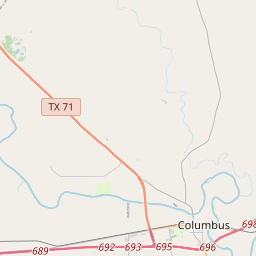Joseph Jefferson Mansfield
Historical marker location:






(Feb. 9, 1861 - July 12, 1947)
Born in Wayne County, West Virginia, as Beauregard Mansfield. His name was changed to Joseph Jefferson Mansfield for his father, a Confederate colonel who was killed soon after Mansfield's birth. Mansfield came to Texas in 1881, studied law, was admitted to the bar in 1886, and opened a law office in Eagle Lake (11 miles SE). While in Eagle Lake, he served as mayor, city attorney, and newspaper editor, and in 1888, married Annie Scott Bruce. The couple had 3 children. In 1892, Mansfield was elected county attorney and moved to Columbus, where in 1896, he was elected county judge. During his tenure as judge, in 1912-13, Mansfield served as Grand Master of the Grand Lodge of
Texas Masons. In 1916, he was elected to the United States Congress.
As a congressman, Mansfield served as the Chairman of the House Rivers and Harbors Committee, which was responsible for federal funding of flood control on the Colorado River. Mansfield Dam (95 miles NW), constructed in 1934, was named in his honor. Early in 1947, Mansfield donated this property to Columbus for construction of a public Library. He died in Washington, D.C. and many dignitaries, including congressman (and later president) Lyndon B. Johnson, attended the funeral in Columbus. Burial was at Eagle Lake
As one of the most visible programs of the Texas Historical Commission (THC), historical markers commemorate diverse topics in Texas history, including: the history and architecture of houses, commercial and public buildings, religious congregations, and military sites; events that changed the course of local and state history; and individuals who have made lasting contributions to the state, community organizations, and businesses.
The state of Texas was once an independent country known as the Republic of Texas. It gained independence from Mexico in 1836 and was a separate nation until it was annexed by the United States in 1845.
During the Republic of Texas era, Colorado County saw rapid growth and development. The county seat, Columbus, was established in 1839 and quickly became a major commercial center. The town served as an important stop on the Old San Felipe Road, a major transportation route connecting East and Central Texas. The discovery of oil and gas in the region in the early 20th century further fueled the county's growth and economic prosperity.
Colorado County played an important role during the Civil War. Many residents of German descent who settled in the county were Union sympathizers, while others supported the Confederacy. The county witnessed several skirmishes and military actions, including the Battle of Columbus in 1862, when Confederate forces repelled a Union raid. After the war, the county slowly rebuilt its economy and infrastructure.
In the 20th century, Colorado County diversified its economy beyond agriculture. The discovery of oil and gas led to the development of a thriving energy industry, and manufacturing and services sectors also grew. Today, Colorado County is a mix of suburban and rural areas, with agriculture, oil and gas, and tourism forming the pillars of its economy. The county continues to preserve its historical sites and celebrate its diverse heritage, attracting visitors from across the state and beyond.
Colorado County Timeline
This timeline provides a concise overview of the key events in the history of Colorado County, Texas.
- 1821: The area that would become Colorado County, TX is included in Austin's Colony, established by the Mexican government.
- 1835: The area plays a role in the Texas Revolution as volunteers from Colorado County participate in the Battle of Gonzales.
- 1837: Colorado County is officially established as a county in the Republic of Texas.
- 1838: Columbus is selected as the county seat.
- 1846: Colorado County is incorporated into the state of Texas as it becomes part of the United States.
- 1850s: The county experiences rapid growth as more settlers move into the area, establishing farms and ranches.
- 1861: With the outbreak of the Civil War, many residents of Colorado County actively support the Confederacy.
- 1870s: The county's economy starts to diversify with the discovery of oil, leading to the establishment of oil wells and refineries.
- 1935: The Lower Colorado River Authority is established, and dams are constructed in the area for flood control and water supply.
- 1970s: Colorado County experiences an agricultural decline as farming becomes less profitable.
- 1997: The Joe R. and Teresa Lozano Long Center for the Performing Arts is opened in Austin, providing a cultural center for the region.